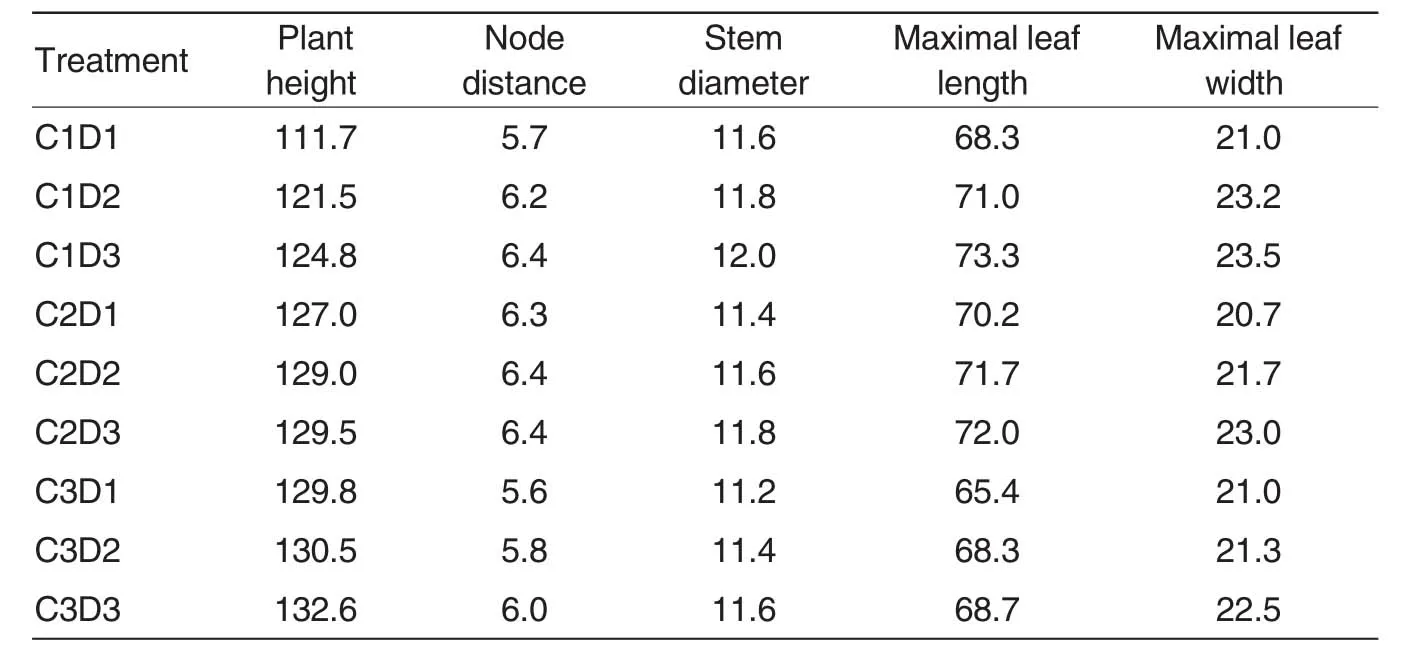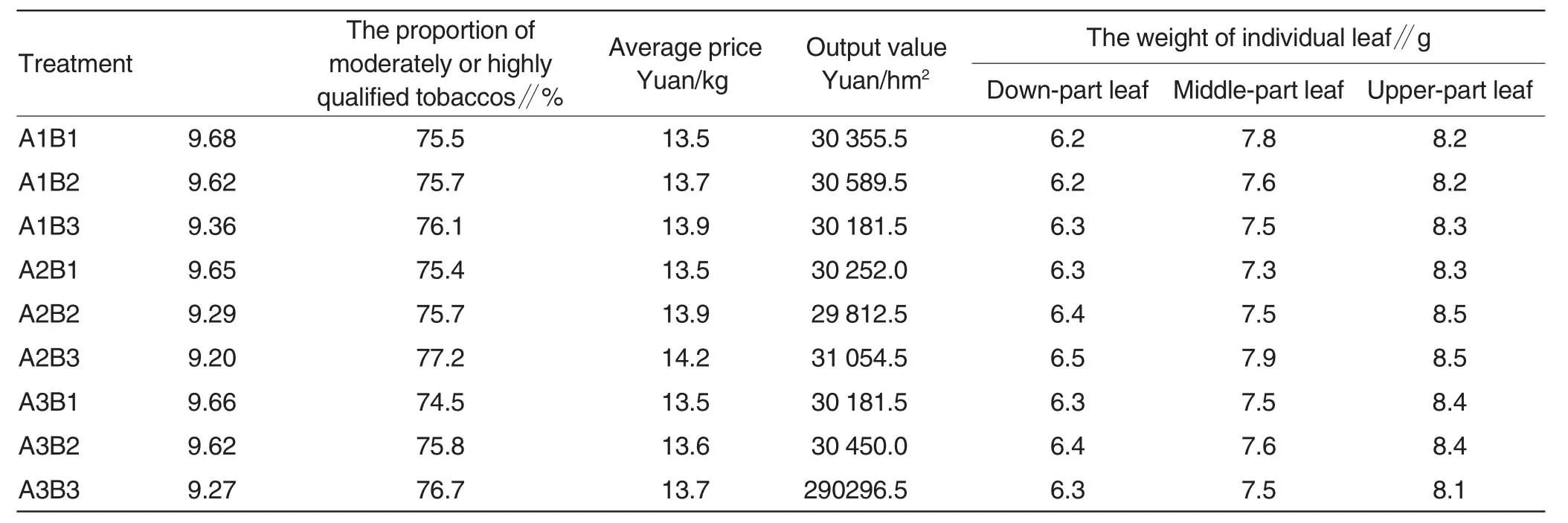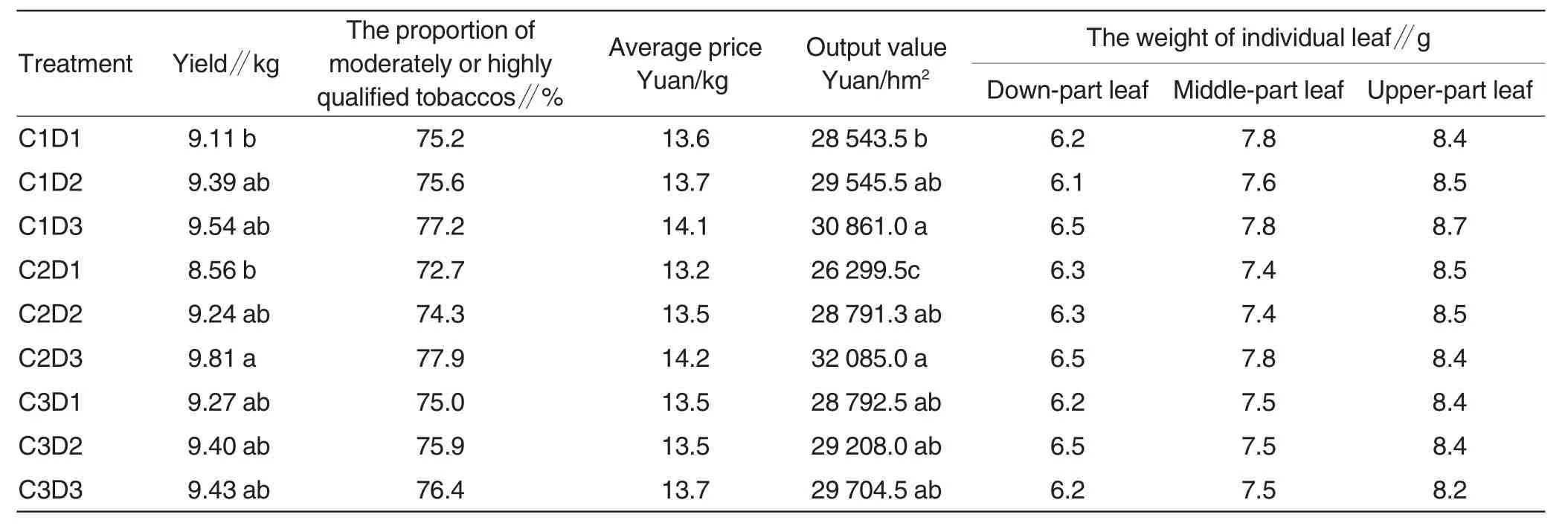Major Cultivation Technology of HQ No.1,a New Flue-cured Tobacco Cultivar
Wenyu LI,Aihua LI
1.College of Agronomy,Hunan Agricultural University,Changsha 410128,China;2.Qidong Industry of Hengyang Tobacco,Hengyang 421600,China
In Hengyang City, Hunan Province,the area of flue-cured tobacco has reached 8 000 hm2,and annual yield is as high as 18 000 t.Tobacco production has become a major project for tobacco farmers to increase incomes,for government to enhance tax and for enterprise to gain benefits[1].Furthermore,the produced tobaccos have been important raw materials forHunan,Guangdong,Hubei and Anhui Industries of China Tobacco[2].It is key for sustainable development of flue-cured tobaccos in Hengyang to introduce and cultivate new flue-cured tobacco cultivars.Meanwhile,corresponding cultivation technology proves crucial for exploiting the advantages of new cultivars to the full and producing excellent tobaccos in order to adapt to development of tobacco industry[3-6].Therefore,the research made exploration on major cultivation technology,involving transplanting period, density, fertilizer amount and the number of left leaves,of HQ No.1,in order to investigate agronomic characters, economic character and the tolerance to disease,as well as the application value in tobacco fields in Hengyang City.
Materials and Methods
Materials
The materials were variant Yunyan No.87 discovered in tobacco fields in Shuangquan Village,Baidishi Town,Qidong County by Hengyang Tobacco Science Institution in 2008,and the cultivar was named HQ No.1 through cultivation process of newly bred cultivars.
Test design
The test was conducted in Dushu Village,Fengshiyan Town,Qidong County,during May-July 2011 and test field was a moderate-fertility paddy field.Besides test treatment,the rest was carried out as per Flue-cured Tobacco Standard Technology in Tobacco Bases of Hengyang.
Transplanting period and density
The test designed three transplanting periods, including treatments A1(March 5),A2 (March 10)and A3(March 15),and the transplanting densities treatments B1(1.2 m×0.5 m),B2(1.2 m×0.55 m)and B3 (1.2 m ×0.6 m).The test used orthogonal?experimental design with two factors and three levels,totaling 9 treatments,three repetitions and 27 test zones(40 m2).Additionally,pure N totaled 165 kg/hm2.
The number of left leaves and fertilizer amountFor individual plant,the number of left leaves was designed in treatments C1 (22 leaves),C2(24 leaves)and C3 (26 leaves),and the applied pure N per hm2included treatments D1(135 kg),D2(165 kg)and D3(195 kg).The proportion of N,P2O5and K2O was 1:1:2;the test design was the same as that of transplanting period and density;the transplanting density was 1.2 m×0.55 m.
The observed item and methods
Agronomic characters,and the disease rates of mosaic disease and potato virus Y were recorded 10 d after pinching.Then,after curing of tobaccos,yield and major economic characters were observed as per related standard[7].
Analytic statistics method
The test data were analyzed with DPS.
Results and Analysis
Effects of transplanting period and density on major agronomic characters of tobaccos
As shown in Table 1,it is leaf size that is the mostly influenced by transplanting period and density.The later transplanting period and sparser the density,the larger width and length of leaves.Among different treatments,plant height,node distance and stem diameter all showed insignificant differences.
Effects of the number of left leaves and fertilizer amounts on major agronomic characters of tobaccos
As shown in Table 2,with increase of the number of left leaves and fertilizer amount,plant height of HQ No.1 kept increasing,and maximal leaf length,leaf width,node distance and stem diameter were all growing upon fertilizers.However,the agronomic characters were declining as the number of left leaf grew.These indicated that the increases of the number of left leaf and fertilizer would improve plant height and fertilizers would advance maximal leaf length,leaf width,node distance,and stem diameter,but the increase of the number of left leaf would prevent the growth of the agronomic characters.
Effects of transplanting period and density on economic characters
As shown in Table 3,tobacco yield maintained growing upon density.Among different treatments,treatment B1 proved the highest of yield,but showed insignificant differences with the rest treatments;the proportion and price of were decreasing upon density.With the complementation,the yield per unit area showed little differences among treatments,and the weight per leaf was much close of upper,middle or lower parts leaves.These indicated that the three transplanting periods and densities were all suitable for HQ No.1 in Hengyang.
Effects of the number of left leaf and fertilizer on economic characters
As shown in Table 4,tobacco yield was growing upon fertilizer,which was also true for proportion and price of moderately or highly qualified tobaccos,with insignificant differences.Because of the growth of proportion and price of moderately or highly qualified tobaccos,yields among different treatments tended to be volatile.Furthermore,the number of left leaf had the least effects on economic characters.Of the treatments,the weights of individual leaf,in upper,middle or lowerparts,changed little,which demonstrated thatHQ No.1 kept more effective leaf,with high tolerance to fertilizer.
Effects of treatments on disease tolerance of tobaccos
The research suggested that the rates of the three diseases were lower in different treatments,but disease damages kept growing up the number of left leaf and fertilizer amount.
Conclusions and Discussions
The test results incorporated that HQ No.1 has more leaves and is of high tolerance to fertilizer and diseases.In Hengyang,highlyNo.quali-fied HQ No.1 can be produced,given that tobaccos are transplanted during March 10-March 15,planting density of 15 000-16 500 seedlings/hm2,the number of left leaves of 22-24 leaves per seedling,and pure N of 150-165 kg/hm2.

Table 1 Major agronomic characters of tobaccos after pinching in the treatments with designed transplanting periods and density cm

Table 2 Major agronomic characters of tobaccos after pinching cm

Table 3 Major economic characters by transplanting period and density

Table 4 Major economic characters of tobaccos in the treatment with the number of left leaf and fertilizer on economic characters
In the research,the concerning time of transplanting period was short,and the interval of treatment periods was just 5 d among different groups,which can not meet the demands of test in transplanting period.Therefore,the agronomic characters and economic characters tended to be volatile,which should be paid attention to.Additionally,considering from production of highly-qualified tobaccos and rotation cultivation systems of tobacco and rice,fertilizer amount and the number of left leaf should be limited in case of degradation of tobacco quality or delay of production season.
[1]YANG X(楊翔).Marketing model of cigarette in Hengyang City in the 3rdgeneration(3G時(shí)代衡陽卷煙銷售模式研究)[J].Brand(品牌),2011(3):25-28.
[2]LUO WW(羅維武).Construction and countermeasures of tobacco production team in Hengyang(淺談衡陽煙葉生產(chǎn)技術(shù)隊(duì)伍建設(shè)及對(duì)策)[J].Crop Researchˉ作物研究),2012(5):8-10.
[3]LI FX(李發(fā)新).Sustainable development of the tobacco produce in the eye of the modern agriculture(從現(xiàn)代農(nóng)業(yè)看煙葉生產(chǎn)的可持續(xù)發(fā)展)[J].Chinese Agricultural Science Bulletin(中國(guó)農(nóng)學(xué)通報(bào)),2007,23(11):44-46.
[4]XUE XP(薛小平),WANG MS(王茂勝),CHEN Y(陳懿).Analysis on the development strategy and trend of Chinese tobacco industry(淺析中國(guó)煙草業(yè)發(fā)展戰(zhàn)略及趨勢(shì))[J].Journal of Anhui Agricultural Sciences(安徽農(nóng)業(yè)科學(xué)),2008,36(7):32-35.
[5]LI JP(李軍萍).Consideration on the modern tobacco agriculture development(發(fā)展現(xiàn)代煙草農(nóng)業(yè)的思考)[J].Journal of Hebei Agricultural Sciences(河北農(nóng)業(yè)科學(xué)),2008,12(9):108-110.
[6]OU YT(歐陽濤),LIU J(劉娟),YUAN HB(袁輝斌).Construction situation and strategic choice of modern tobacco agriculture in Hunan(現(xiàn)代煙草農(nóng)業(yè)建設(shè)的“三維”模式及其實(shí)施方略)[J].Journal of Hunan AgriculturalUniversity(Social Sciences)(湖南農(nóng)業(yè)大學(xué)學(xué)報(bào):社會(huì)科學(xué)版),2010,11(2):18-23
[7]State tobacco monopoly administration(國(guó)家煙草專賣局).Investigating and measuring methods ofagronomical character of tobacco(煙草農(nóng)藝性狀調(diào)查測(cè)量方法)[M].Beijing:China Standard Press(北京:中國(guó)標(biāo)準(zhǔn)出版社),2010.
 Agricultural Science & Technology2015年3期
Agricultural Science & Technology2015年3期
- Agricultural Science & Technology的其它文章
- Analysis of the Causes of Continuous Cropping Obstacles for Atractylodes macrocephala Koidz in Pingjiang County and Its Control Methods
- Overview of Pharmacological Research on Adonis L.
- Research Progress of Special Wheat Nutrition Components and Application
- Human Settlements in Rural-urban Fringe
- The Effect of Three New Fungicides against Rice Sheath Blight in Field Experiment
- Overview of Pharmacological&Ecological Research of Scirpus tabernaemontani Gmel
